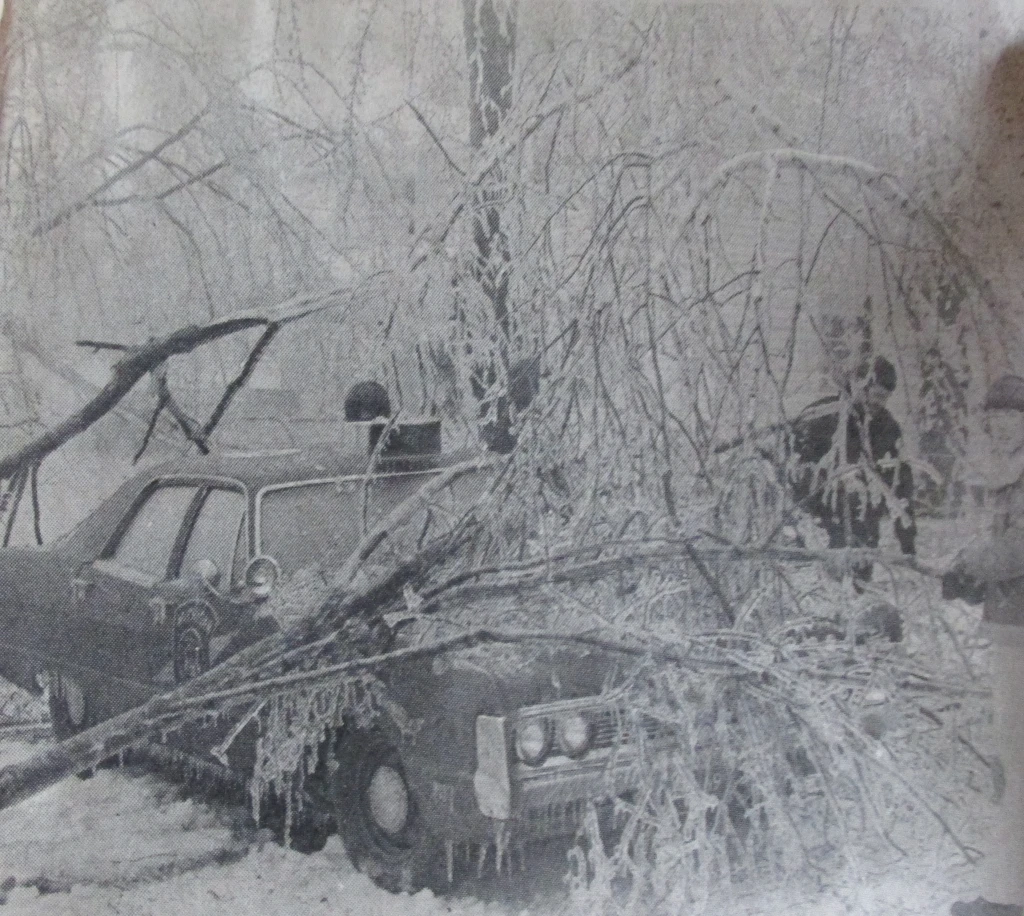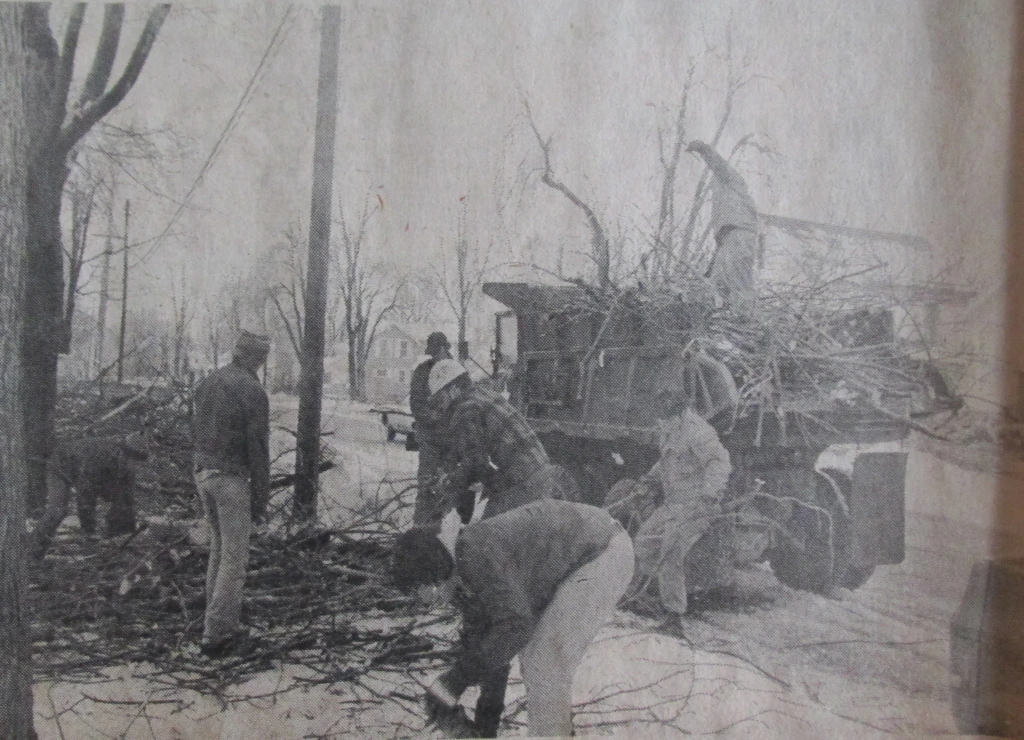



Above: National Guardsmen and Consumers Power crews worked furiously to try and deal with the ice storm. During the first few days, their efforts were challenged by the ever-changing weather conditions.
Record warm temperatures in Gratiot County on February 28, 1976, suggested that spring was on its way – or so many people thought. On Monday, March 1, a thirty-degree temperature drop combined with snow, rain, and even thunderstorms led to the beginning of the ice storm of 1976.
The next evening, the district boys’ basketball game at Ithaca High School pitted a heavily favored St. Louis squad against an Ithaca team that had won only a few games all season. As the contest proceeded, it was interrupted several times by flickering lights and temporary power losses. With only 42 seconds left, Ithaca’s Kent Kirby hit a shot that gave Ithaca a 64-63 upset win – and then the lights in the Ithaca gym went out for good. Everyone there, as well as most of the city of Ithaca, dealt with almost total darkness. Boys’ basketball games were soon called off in many places because schools did not have power. A total of 44 games in two nights were postponed across the state.
Early the next day, at least 3,000 people were without power in Ithaca. Things were not good in the city of Alma either, as 4 inches of snow and over 2 inches of ice had fallen the night before. The roads around Gratiot County quickly became impassable, with 60 percent of them blocked by fallen trees, limbs, and debris. Phone systems went out, and the first Consumers Power work crews came in from Mt. Pleasant to help.
Dr. Don Gardner of St. Louis immediately set up a mobile command station at the Ithaca Police Post. Gardner’s vehicle measured 27 feet long and was equipped with a 110-volt generator, oven, and stove that he purchased as a mobile medical unit the year before. He and his group remained on duty for the next five days to help people. Another emergency center was set up at the Michigan Masonic Home in Alma. CB radio volunteers made up another group that tried to help. They reached 90 percent of rural Gratiot County within 48 hours by contacting families and then visiting homes that needed help.
During the storm, Gratiot County citizens did their best to cope with the severe weather conditions. People lined up outside of grocery stores starting early on March 2, but they needed flashlights to find items in the aisles. Cashiers could not use their electrically-operated registers and used battery-powered calculators to add purchases. Bread, lunch meat, hot dogs, paper plates, flashlights, batteries, and beer all went quickly. At least one grocery store sold meat at half price for fear of spoiling. Ice cream was given away for free, even as it dripped out of the freezers.
The ice storm affected many other places as well. Larry’s Hardware in Ithaca saw 2,000 people come through its doors on March 2-3. Most people wanted flashlights, batteries, and lanterns, but they were all sold out by noon on Wednesday. To cope with the customer traffic, the store soon had to display a notice on the front door about the many items that Larry’s no longer had. Police and the sheriff’s departments gave extra surveillance to banks, even as people came and went to finance loans to purchase generators – if they could find one to buy. WFYC radio station went off the air for 36 hours until Midland Dow loaned a generator along with two men to show how to use it. Schools throughout the county were out for the week. Over at Ashley High School, volunteers served soup and hot food for those in the village who needed something to eat. Maple Rapids Elementary School also provided food. Gratiot Community Hospital ran on emergency power for over eight hours on March 3. Hospital employees walked to work and exhibited good morale, despite working 16-hour shifts. Gas stations had no power, and many could not pump gasoline. One Ithaca station sold 6,000 gallons of gasoline on one day alone, six times the usual amount. Gas disappeared by Thursday. However, a supply truck had the station running again by Friday.
At mid-week, the ice storm had failed to let up and continued to wreak even more havoc. Freezing rain came down on that Wednesday, accompanied by thunderstorms, which left another half-inch of ice on trees as the storm moved from southwest Gratiot County to the northeast. In addition, flooding took place along the Maple River, threatening homes in that area. Morbark sent volunteers to Alma to help with down trees while Governor William Milliken officially declared Michigan to be in a state of emergency. To provide more help to Gratiot County, 60 National Guardsmen from the 125th Infantry Alma Armory and the 1345th Engineer Battalion, Company A, from Midland, went to work in the county. During the same time, Consumers Power continued to call in extra crews from out of the state. The National Guardsmen and Consumers Power crews fought to get lines operating again by removing downed trees but then turned to another line (or two) that soon went down due to even more falling branches. At this point of the ice storm, most Gratiot residents were told not to expect full power until as late as Sunday. Alma and St. Louis now had 60 percent of their residents without power, while areas east and south Gratiot County had no power at all. Places like Pompeii, North Star, Middleton, Elwell, Elm Hall, and Sumner lacked water. Residents had to boil water, and food freezers needed to be emptied after 72 hours.
By Thursday of that week, Gratiot County experienced high winds. In places like Ithaca, which had gotten power back at 8:45 pm, the winds now knocked out another 40 percent of the town. The same happened in Alma, which had also regained power, only to see 60 percent lose again. Life seemed better in St. Louis and Breckenridge, where 90 percent of the residents got their power back. Ashley and southwest Gratiot still had none, nor did many who lived south of Breckenridge. General Telephone said that the county had 1,039 service drops and 150 significant cable breaks that needed to be fixed. As to travel, roads remained shut down throughout approximately one-third of the county. Chlorinated water supplies had been sent to Elm Hall, Elwell, Sumner, Middleton, and Pompeii as food and water shortages remained severe problems. Amidst the continued bad weather, another group of 200 Consumers Power linemen from Chicago arrived in the county.
Even though things initially looked grim that week, by the weekend the situation improved enough that Gratiot County residents could move about in certain places. Many roads were now clear, but drivers still ran into areas with dropped limbs and downed power lines. The National Guard was deactivated by Saturday afternoon, and Dr. Gardner closed his command post in Ithaca. Another Red Cross emergency center which had been opened at Alma College now moved to the First Methodist Church. The Red Cross continued to offer food to people at the Ithaca High School cafeteria, and they provided places to stay in town for those in need. Approximately 70 percent of General Telephone customers in the county now had their phone lines back.
Other stories emerged about those who came to help Gratiot County. Consumers Power set up a command post for work crews at the Edgewood Conservation Club on Barry Road. Work along east Gratiot County seemed never-ending. At least 36 linemen set 380 poles and over 40 miles of wiring along 12 square miles. Their biggest challenge, aside from working 14-18 hour days, was the mud, which hindered the setting of the poles. The new telephone poles had to be shipped in, coming from as far away as Louisiana and Mississippi. As tired as they were, these Consumers Power crewmen found food and coffee breaks at the Breckenridge United Methodist Church, where 40 dedicated women fed a total of 80 linemen from the county throughout that week.
Normal daily life in Gratiot County gradually resumed. However, there were long-term effects of the ice storm of 1976, especially concerning cleanup in villages, towns, and townships. A week after the storm, Alma estimated its damages to be more than $540,000 and that it would take 60 working days to clean up the city. It was expected to take 21 working days just to get all branches off the streets and sidewalks. The St. Louis City Council had a similar problem and considered how to deal with $190,000 in damages. The council received an offer of volunteer help from students at Northwood Institute. However, city attorneys feared that downed power lines, injuries, and accompanying lawsuits were too much risk to accept the students’ help.
The city of Ithaca had another idea about their cleanup. On Saturday, March 13, city hall issued a call for help through “Operation Twiggy.” Pastor David Nelson of the Ithaca United Methodist Church chaired a group of organizations made up of the Ithaca Chamber of Commerce, Ithaca Rotary Club, Lions Club, Ithaca Jaycees, and the Ithaca Ministerial Association. These all came together to ask people to clean up Ithaca. Approximately 200 people and 40 vehicles worked that Saturday, beginning at 8:00 am. Volunteers were told only to pick up large items like branches and debris along streets and sidewalks in Ithaca and not enter private property. Homeowners, in turn, were told they were responsible for small pick up of items on their lawns. On that Saturday, a steady flow of trucks and vehicles loaded from the pickup point ran from Ithaca west to the landfill on Washington Road. County-wide, “Operation Effort” also took place on that day. As part of a more extensive county-wide cleanup, volunteers met at their township halls at 9:00 am and brought chainsaws, pickups, trailers, and trucks. A total of 32 volunteers showed up at North Star Township Hall to work on that day. Other things became apparent after the ice storm. Initial damages to Gratiot County, first estimated to be at $5.5 million, rose to $6.25 million at the end of March. Residents had to deal with damaged trees for some time to come, and the county guided people to save those trees that remained largely intact. People in Gratiot County received warnings about potential damage to LP gas regulators, which could still be iced over and clogged. Many homeowners also had to hire electricians to reconnect their electric entrance cables to their meter sockets because Consumers Power only repaired the actual lines. Warnings went out to the public to beware of imposters posing as Consumers Power workers who charged a fee to repair remaining downed lines. To help those who applied for federal assistance, the Alma Community Center became the place for making claims for damages or asking for information about claims.
As people started to put the disaster behind them, discussions began to take place about how to better prepare in the future for emergencies like the ice storm of 1976. This storm forced leaders to consider changing some ideas from the old Civil Defense plans that existed during the Cold War.
One positive result of the ice storm involved how people in the county looked after and took care of each other. Letters to the editor in newspapers commented how many in the county had pulled together to face the crisis. Gratiot County had survived. The ice storm of 1976 had brought out the best in Gratiot County’s citizens.
Copyright 2022 James M Goodspeed



